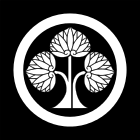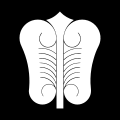Kuwana Domain
Kuwana Domain (桑名藩 Kuwana-han) was a Japanese domain of the Edo period, located in Ise Province (modern-day Mie Prefecture), Japan. It was centered on Kuwana Castle in what is now the city of Kuwana, Mie.
History
During the late Heian period and Muromachi period, the area of modern Kuwana was known as Juraku-no-tsu (十楽の津)and was a major seaport on the east coast of Japan, controlled by a guild of merchants. The poet Socho described it in 1515 as a major city with over a thousand houses, temples and inns. During the Sengoku period, the area came under the control of Oda Nobunaga, who assigned it to his retainer, Takigawa Kazumasu. After Nobunaga’s death, the area came under the control of Toyotomi Hideyoshi, who initially installed Nobunaga’s younger son Oda Nobukatsu as ruler as all of Ise Province. However, following the Battle of Odawara, Hideyoshi demoted Oda Nobukatsu, divided Ise Province into several domains, and assigned Hitotsuyanagi Naomori as ruler of Kuwana. In 1595, the area was reassigned to Ujiie Yukihiro as a 22,000 koku domain. Ujiie Yukihiro sided with the pro-Toyotomi armies in the Battle of Sekigahara and was dispossessed by Tokugawa Ieyasu.
In January 1601, one of Ieyasu’s main generals, Honda Tadakatsu was installed as daimyō of Kuwana Domain, with revenues of 100,000 koku. The Tokugawa Shogunate recognized the strategic value of the location as both a seaport, and also as Kuwana-juku, a post station on the vital Tōkaidō highway connecting Edo with Kyoto. In 1609, Tadakatsu was succeeded by his son Honda Tadamasa, who distinguished himself at the Siege of Osaka and was rewarded with a transfer to the more lucrative Himeji Domain in 1617.
The strategic Kuwana Domain was then assigned to Ieyasu’s half-brother, Hisamatsu Sadakatsu, whose descendants ruled until they were transferred to Takada Domain in Echigo Province in 1710, and their place taken by the Okudaira branch of the Matsudaira clan, who ruled to 1823, when a branch of the Hisamatsu returned to Kuwana from Shirakawa Domain in Mutsu Province. The Hisamatsu continued to rule Kuwana until the end of the Tokugawa shogunate.
Matsudaira Sadaaki, the next-to-last daimyō of Kuwana served as the last Kyoto shoshidai and supported his brother, Matsudaira Katamori, daimyo of Aizu Domain. He fought in the Boshin War, finally surrendering to the Meiji government after the fall of the Republic of Ezo.The final daimyō of Kuwana, Matsudaira Sadanori, was still a child during the Boshin War. He capitulated Kuwana Castle to the Satchō Alliance forces without a battle. He was later educated in the United States and joined the Meiji government, serving as Japanese ambassador to Italy. He was later ennobled with the kazoku peerage title of shishaku (viscount).
With the abolition of the han system in July 1871, Kuwana Domain became “Kuwana Prefecture”, which later became part of Mie Prefecture.
Territory
As with all of the Japanese feudal domains, Kuwana Domain was not a single contiguous territory, but consisted of a number of scattered holdings. At the end of the Edo period, it consisted of numerous villages in Ise Province and also in Echigo Province:
Ise Province
- 64 villages in Kuwana District
- 83 villages in Inabe District
- 30 villages in Asake District
- 9 villages in Mie District
Echigo Province
- 4 villages in Koshi District
- 22 villages in Uonuma District
- 82 villages in Kariwa District
- 30 villages in Santo District
- 7 villages in Kambara District
In addition to the above, Kuwana Domain also administered 212 villages within Echigo Province which were tenryo territory on behalf of the shogunate.
List of daimyō
-
 Honda clan (fudai) 1601-1616
Honda clan (fudai) 1601-1616
| # | Name | Tenure | Courtesy title | Court Rank | revenues |
|---|---|---|---|---|---|
| 1 | Honda Tadakatsu ( 本多忠勝) | 1601-1609 | Nakatsu-no-daisuke | Lower 5th (従五位下) | 100,000 koku |
| 2 | Honda Tadamasa ( 本多忠政) | 1609-1616 | Mino-no-kami | Lower 4th (従四位下) | 100,000 koku |
-
 Hisamatsu clan (shimpan) 1616-1710
Hisamatsu clan (shimpan) 1616-1710
| # | Name | Tenure | Courtesy title | Court Rank | revenues |
|---|---|---|---|---|---|
| 1 | Hisamatsu Sadakatsu (久松定勝) | 1616–1624 | Oki-no-kami; Sakon-no-shosho | Lower 4th (従四位下) | 110,000 koku |
| 2 | Hisamatsu Sadayuki ( 久松定行) | 1624-1635 | Sado-no-kami | Lower 5th (従五位下) | 110,000 koku |
| 3 | Matsudaira Sadatsuna ( 松平定綱) | 1635–1651 | Etchu-no-kami | Lower 4th (従四位下) | 110,000 koku |
| 4 | Matsudaira Sadayoshi ( 松平定良) | 1652–1657 | Sado-no-kami | Lower 5th (従五位下) | 110,000 koku |
| 5 | Matsudaira Sadashige ( 松平定重) | 1657-1710 | Etchu-no-kami | Lower 5th (従五位下) | 110,000 koku |
-
 Okudaira clan (fudai) 1710-1823
Okudaira clan (fudai) 1710-1823
| # | Name | Tenure | Courtesy title | Court Rank | revenues |
|---|---|---|---|---|---|
| 1 | Matsudaira Tadamasa ( 松平忠雅) | 1710–1746 | Shimosa-no-kami; Sakon-no-shosho | Lower 4th (従四位下) | 100,000 koku |
| 2 | Matsudaira Tadatoki ( 松平忠刻) | 1746-1771 | Shimosa-no-kami | Lower 4th (従四位下) | 100,000 koku |
| 3 | Matsudaira Tadahira ( 松平忠啓) | 1771–1786 | Shimosa-no-kami | Lower 4th (従四位下) | 100,000 koku |
| 4 | Matsudaira Tadakatsu ( 松平忠功) | 1787–1793 | Shimosa-no-kami | Lower 4th (従四位下) | 100,000 koku |
| 5 | Matsudaira Tadatomo ( 松平忠和) | 1793-1802 | Shimosa-no-kami | Lower 4th (従四位下) | 100,000 koku |
| 6 | Matsudaira Tadasuke ( 松平忠翼) | 1802-1821 | Shimosa-no-kami | Lower 4th (従四位下) | 100,000 koku |
| 7 | Matsudaira Tadataka ( 松平忠堯) | 1821-1823 | Mibu-Daiyu | Lower 4th (従四位下) | 10,000 koku |
-
 Hisamatsu clan (shimpan) 1823-1871
Hisamatsu clan (shimpan) 1823-1871
| # | Name | Tenure | Courtesy title | Court Rank | revenues |
|---|---|---|---|---|---|
| 1 | Matsudaira Sadanaga ( 松平定永) | 1823–1838 | Etchu-no-kami; Sakon-no-shosho | Lower 4th (従四位下) | 113,000 koku |
| 2 | Matsudaira Sadakazu ( 松平定和) | 1838-1841 | Etchu-no-kami; Sakon-no-shosho | Lower 4th (従四位下) | 113,000 koku |
| 3 | Matsudaira Sadamichi ( 松平定猷) | 1842–1858 | Etchu-no-kami; Jiju | Lower 4th (従四位下) | 113,000 koku |
| 4 | Matsudaira Sadaaki ( 松平定敬) | 1859–1868 | Etchu-no-kami; Sakon-no-shosho | Lower 4th (従四位下) | 113,000 koku |
| 5 | Matsudaira Sadanori ( 松平定教) | 1868-1871 | -none- | 4th (正四位下) | 113,000-->60,000 koku |
References
- Papinot, E (1910). Historical and Geographic Dictionary of Japan. Tuttle (reprint) 1972.
- (Japanese) Kuwana on "Edo 300 HTML"